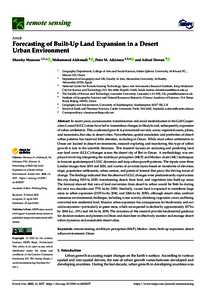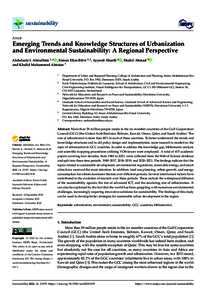Document
Forecasting of built-up land expansion in a desert urban environment.
Identifier
DOI: 10.3390/rs14092037
Source
Remote Sensing. v. 14, 9, 2037
Contributors
Country
Switzerland
Publisher
MDPI.
Gregorian
2022-05-01
Language
English
Subject
English abstract
In recent years, socioeconomic transformation and social modernisation in the Gulf Cooperation Council (GCC) states have led to tremendous changes in lifestyle and, subsequently, expansion of urban settlements. This accelerated growth is pronounced not only across vegetated coasts, plains, and mountains, but also in desert cities. Nevertheless, spatial simulation and prediction of desert urban patterns has received little attention, including in Oman. While most urban settlements in Oman are located in desert environments, research exploring and monitoring this type of urban growth is rare in the scientific literature. This research focuses on analysing and predicting land use–land cover (LULC) changes across the desert city of Ibri in Oman. A methodology was employed involving integrating the multilayer perceptron (MLP) and Markov chain (MC) techniques to forecast spatiotemporal LULC dynamics and map urban growth patterns. The inputs were three Landsat images from 2010 and 2020, and a series of covariate layers based on transforms of elevation, slope, population settlements, urban centres, and points of interest that proxy the driving forces of change. The findings indicated that the observed LULC changes were predominantly rapid across the city during 2010 to 2020, transforming desert, bare land, and vegetation into built-up areas. The forecast showed that area of land conversion from desert to urban would be 5666 ha during the next two decades and 7751 ha by 2050. Similarly, vacant land is expected to contribute large areas to urban expansion (2370 ha by 2040, and 3266 ha by 2050), although desert cities confront numerous environmental challenges, including water scarcity, shrinking vegetation cover, and being converted into residential land. Massive urban expansion has consequences for biodiversity and natural ecosystems—particularly in green areas, which are expected to decline by approximately 107 ha by 2040 (i.e., 10%) and 166 ha by 2050. The outcomes of this research provide fundamental guidance for decision-makers and planners in Oman and elsewhere to effectively monitor and manage desert urban dynamics and sustainable desert cities.
ISSN
2072-4292
Resource URL
Category
Journal articles


